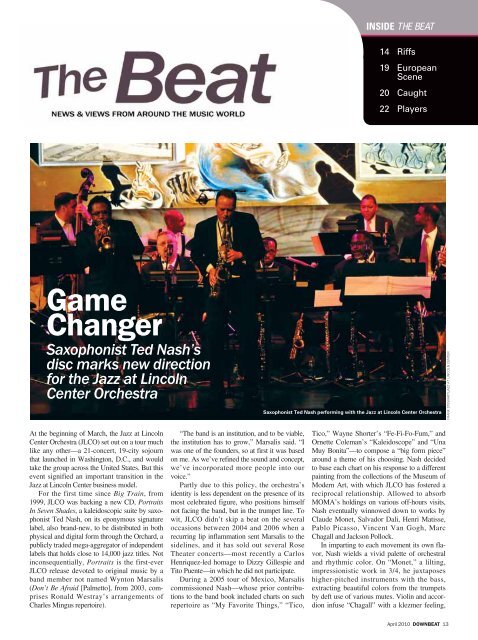Download - Downbeat
Download - Downbeat
Download - Downbeat
- TAGS
- download
- downbeat
- downbeat.com
Create successful ePaper yourself
Turn your PDF publications into a flip-book with our unique Google optimized e-Paper software.
Game<br />
Changer<br />
Saxophonist Ted Nash’s<br />
disc marks new direction<br />
for the Jazz at Lincoln<br />
Center Orchestra<br />
At the beginning of March, the Jazz at Lincoln<br />
Center Orchestra (JLCO) set out on a tour much<br />
like any other—a 21-concert, 19-city sojourn<br />
that launched in Washington, D.C., and would<br />
take the group across the United States. But this<br />
event signified an important transition in the<br />
Jazz at Lincoln Center business model.<br />
For the first time since Big Train, from<br />
1999, JLCO was backing a new CD, Portraits<br />
In Seven Shades, a kaleidoscopic suite by saxophonist<br />
Ted Nash, on its eponymous signature<br />
label, also brand-new, to be distributed in both<br />
physical and digital form through the Orchard, a<br />
publicly traded mega-aggregator of independent<br />
labels that holds close to 14,000 jazz titles. Not<br />
inconsequentially, Portraits is the first-ever<br />
JLCO release devoted to original music by a<br />
band member not named Wynton Marsalis<br />
(Don’t Be Afraid [Palmetto], from 2003, comprises<br />
Ronald Westray’s arrangements of<br />
Charles Mingus repertoire).<br />
“The band is an institution, and to be viable,<br />
the institution has to grow,” Marsalis said. “I<br />
was one of the founders, so at first it was based<br />
on me. As we’ve refined the sound and concept,<br />
we’ve incorporated more people into our<br />
voice.”<br />
Partly due to this policy, the orchestra’s<br />
identity is less dependent on the presence of its<br />
most celebrated figure, who positions himself<br />
not facing the band, but in the trumpet line. To<br />
wit, JLCO didn’t skip a beat on the several<br />
occasions between 2004 and 2006 when a<br />
recurring lip inflammation sent Marsalis to the<br />
sidelines, and it has sold out several Rose<br />
Theater concerts—most recently a Carlos<br />
Henriquez-led homage to Dizzy Gillespie and<br />
Tito Puente—in which he did not participate.<br />
During a 2005 tour of Mexico, Marsalis<br />
commissioned Nash—whose prior contributions<br />
to the band book included charts on such<br />
repertoire as “My Favorite Things,” “Tico,<br />
INSIDE THE BEAT<br />
14 Riffs<br />
19 European<br />
Scene<br />
20 Caught<br />
22 Players<br />
Saxophonist Ted Nash performing with the Jazz at Lincoln Center Orchestra<br />
Tico,” Wayne Shorter’s “Fe-Fi-Fo-Fum,” and<br />
Ornette Coleman’s “Kaleidoscope” and “Una<br />
Muy Bonita”—to compose a “big form piece”<br />
around a theme of his choosing. Nash decided<br />
to base each chart on his response to a different<br />
painting from the collections of the Museum of<br />
Modern Art, with which JLCO has fostered a<br />
reciprocal relationship. Allowed to absorb<br />
MOMA’s holdings on various off-hours visits,<br />
Nash eventually winnowed down to works by<br />
Claude Monet, Salvador Dali, Henri Matisse,<br />
Pablo Picasso, Vincent Van Gogh, Marc<br />
Chagall and Jackson Pollock.<br />
In imparting to each movement its own flavor,<br />
Nash wields a vivid palette of orchestral<br />
and rhythmic color. On “Monet,” a lilting,<br />
impressionistic work in 3/4, he juxtaposes<br />
higher-pitched instruments with the bass,<br />
extracting beautiful colors from the trumpets<br />
by deft use of various mutes. Violin and accordion<br />
infuse “Chagall” with a klezmer feeling,<br />
FRANK STEWART/JAZZ AT LINCOLN CENTER<br />
April 2010 DOWNBEAT 13

















